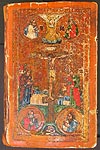Tetraevangelion.
1631. Scribe: Maxim Ulitsky. 18th century painting on front cover of binding.
F (297 ı 185). 299 leaves. The end is missing.
Paper. Ink, cinnabar, colours.
It is written in a semi-uncial hand.
There are 4 head-pieces and initials, executed in imitation of the Old Printed style and the Balkan one (fols. 16r, 109r, 171r, 265r).
The binding consists of boards covered with leather. The front board of the binding is decorated with a painting of the Crucifixion, made in the first half of the 18th century. The inside of the upper board has a hollowed rectangular cavity. It is very likely that a reliquary for the bones of a saint or other sacred relics were enclosed in this cavity.
The scribe Maxim Ulitsky's inscription on folio 166v tells of the creation of the codex in 1631, noting the name of the woman, who commissioned the manuscript, payed 18 zloty ("golden") for it and donated it to the church of Saint Paraskevi Pyatnitsa ("Friday").
The handwritten Tetraevangelion of West Russian origin was acguired by Professor of the Kievan University Yu. A. Yavorsky (1873ñ1937) in 1907.
In 1917 the manuscript came into the Imperial Public Library along with the collection of Yu. A. Yavorsky.
Shelfmark: –Õ¡. þ‚ÓÒÍ. 30.





